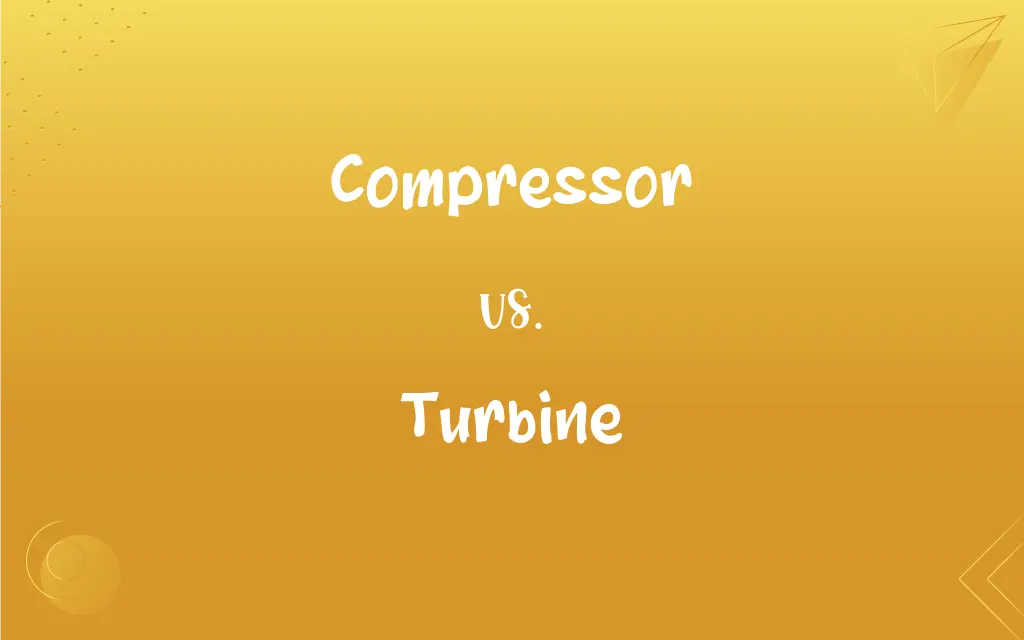Compressor vs. Turbine: What's the Difference?
Edited by Aimie Carlson || By Janet White || Published on March 23, 2024
A compressor increases the pressure of a gas or air, while a turbine extracts energy from a fluid or gas to produce work.

Key Differences
A compressor is a mechanical device that increases the pressure of a gas by reducing its volume, essential in refrigeration, air conditioning systems, and industrial processes. Turbines, on the other hand, are devices that convert the energy in a fluid or gas into mechanical work by rotating a shaft.
The primary function of a compressor is to compress a working fluid, thereby increasing its pressure; turbines perform the opposite function by expanding fluid to produce work.
Compressors are used to power a variety of machines and processes, including jet engines and HVAC systems, whereas turbines are key components in power generation, including steam, gas, and hydroelectric power plants.
Compressors require energy to compress the fluid, while turbines generate energy by harnessing the kinetic or potential energy of fluids.
Comparison Chart
Function
Increases pressure of a gas by reducing its volume
Converts fluid or gas energy into mechanical work
ADVERTISEMENT
Energy Direction
Consumes energy to increase fluid pressure
Produces energy by expanding fluid
Applications
HVAC systems, refrigeration, air compression
Power generation, propulsion systems
Operation Principle
Works by compressing and transporting fluid
Works by extracting energy from fluid flow
Types
Reciprocating, rotary, centrifugal
Steam, gas, hydroelectric, wind
Compressor and Turbine Definitions
Compressor
Used in refrigeration to circulate refrigerant.
The refrigerator's compressor keeps the interior cold.
ADVERTISEMENT
Turbine
Used in wind farms to convert wind energy into electrical energy.
The wind turbine produces clean energy from the wind.
Compressor
An integral part of air conditioning systems.
The compressor failed, causing the AC to stop working.
Turbine
A machine for generating rotary mechanical power from the energy of a stream of fluid.
The hydroelectric plant uses a turbine to generate electricity.
Compressor
A device that increases the pressure of air or gas.
The air compressor filled the tires quickly.
Turbine
Utilized in steam power plants to generate electricity.
Steam turbines are efficient at converting heat into electrical power.
Compressor
Enhances performance in engines by forcing more air into the combustion chamber.
The turbocharger uses a compressor for increased power.
Turbine
In marine applications, it propels ships by converting thermal energy into mechanical work.
The naval destroyer is powered by a steam turbine.
Compressor
A tool in audio production for dynamic range control.
He used a compressor to even out the vocal levels in the mix.
Turbine
A component of jet engines that extracts energy from high-velocity exhaust gases.
The jet engine's turbine drives the compressor.
Compressor
A pump or other machine that increases the pressure of a gas.
Turbine
Any of various machines in which the kinetic energy of a moving fluid is converted to mechanical power by the impulse or reaction of the fluid with a series of buckets, paddles, or blades arrayed about the circumference of a wheel or cylinder.
Compressor
An instrument or device that compresses, such as a forceps or clamp.
Turbine
Any of various rotary machines that use the kinetic energy of a continuous stream of fluid (a liquid or a gas) to turn a shaft.
Turbine
A water wheel, commonly horizontal, variously constructed, but usually having a series of curved floats or buckets, against which the water acts by its impulse or reaction in flowing either outward from a central chamber, inward from an external casing, or from above downward, etc.; - also called turbine wheel.
Turbine
A type of rotary engine with a set of rotating vanes, diagonally inclined and often curved, attached to a central spindle, and obtaining its motive force from the passage of a fluid, as water, steam, combusted gases, or air, over the vanes. Water turbines are frequently used for generating power at hydroelectric power stations, and steam turbines are used for generating power from coal- or oil-fired electric power stations. Turbines are also found in jet engines, and in some automobile engines.
Turbine
Rotary engine in which the kinetic energy of a moving fluid is converted into mechanical energy by causing a bladed rotor to rotate
FAQs
Where are compressors used?
Compressors are used in air conditioning systems, refrigeration, pneumatic tools, and gas pipelines.
What is a compressor?
A compressor is a device that increases the pressure of a gas by decreasing its volume.
How do turbines work?
Turbines work by extracting energy from a fluid or gas as it passes through the blades of the turbine, causing it to spin.
How do compressors work?
Compressors work by taking in air or gas, reducing its volume, and thus increasing its pressure.
Can turbines be used in cars?
While not common, turbines have been experimented with for use in cars, primarily for their propulsion systems.
Do turbines always produce electricity?
While turbines often produce electricity, they can also be used for mechanical work, such as in propulsion systems.
Where are turbines used?
Turbines are used in power generation plants, jet engines, and wind farms.
Are compressors and turbines related?
They are related in principle, as both deal with the movement and pressure of gases, but their functions are opposite.
Can compressors generate power?
Compressors consume power to increase gas pressure; they do not generate power.
What is a turbine?
A turbine is a mechanical device that converts the energy in a fluid or gas into mechanical work by rotating a shaft.
What types of compressors are there?
There are reciprocating, rotary screw, and centrifugal compressors.
Can turbines work with any fluid?
Turbines can work with any fluid, including water, steam, air, and gas, as long as there is sufficient flow and energy.
What is the primary benefit of using a turbine?
The primary benefit is the efficient conversion of fluid energy into mechanical work or electricity.
What types of turbines are there?
Types include steam, gas, hydroelectric, and wind turbines.
How is the efficiency of compressors and turbines measured?
Efficiency is measured by the ratio of the work output to the energy input.
Are compressors used in power plants?
Yes, compressors are used in gas turbine power plants to compress air before it enters the combustion chamber.
What maintenance does a compressor require?
Compressors require regular checks for leaks, filter changes, and oil level checks.
What maintenance does a turbine require?
Turbine maintenance includes regular inspections, lubrication, and blade condition monitoring to ensure efficient operation.
What is the biggest advantage of using a compressor?
The biggest advantage is the ability to increase pressure for various industrial, automotive, and HVAC applications.
How do wind turbines work without a fluid?
Wind turbines work with air as the fluid, converting kinetic energy from wind into mechanical energy.
About Author
Written by
Janet WhiteJanet White has been an esteemed writer and blogger for Difference Wiki. Holding a Master's degree in Science and Medical Journalism from the prestigious Boston University, she has consistently demonstrated her expertise and passion for her field. When she's not immersed in her work, Janet relishes her time exercising, delving into a good book, and cherishing moments with friends and family.
Edited by
Aimie CarlsonAimie Carlson, holding a master's degree in English literature, is a fervent English language enthusiast. She lends her writing talents to Difference Wiki, a prominent website that specializes in comparisons, offering readers insightful analyses that both captivate and inform.
































































